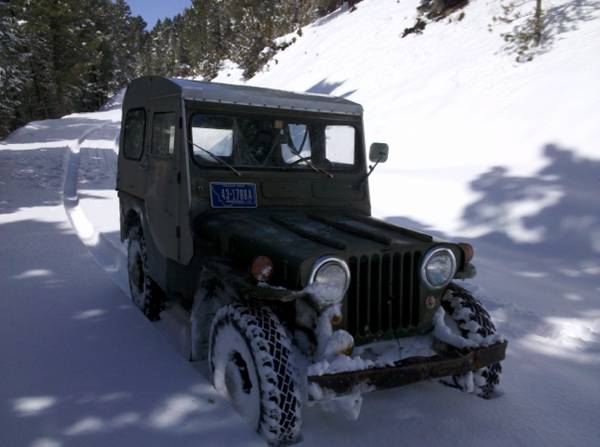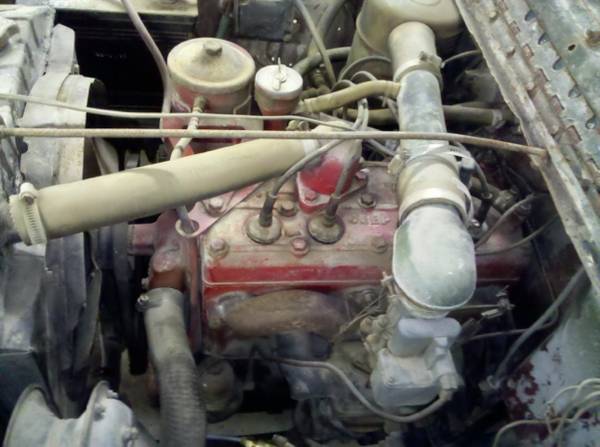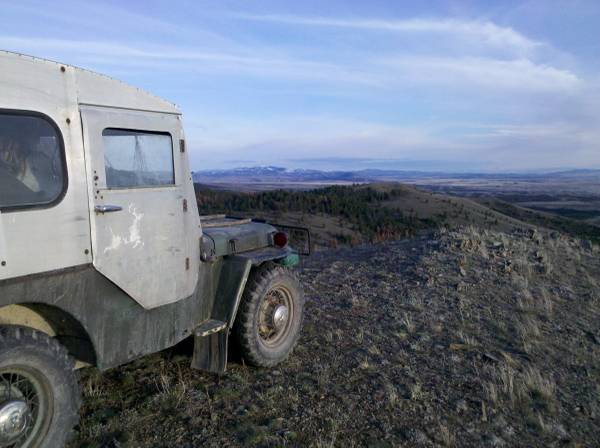UPDATE: **SOLD** Was $3000.
(02/09/2016) This might be a good price.
“1949 willy’s jeep, original engine, been rebuilt, runs perfect does not burn oil, brakes are good, factory rear PTO, converted to 12 volt, spoked wheels with good tires,”
emailNeed to contact me and don't have my email? Click on email button.

Welcome to eWillys.com, a website for vintage jeep enthusiasts. I update this website nearly every day with jeep deals, jeep history, interesting reader projects, jeep related info, and more.
These quick searches can help you find things on eBay. People list in the wrong categories all the time, so don't be surprised to see brochures in the parts area for example.
The links to posts below show jeeps grouped by models, condition, and other ways. Some of these jeeps are for sale and others have been sold. If you are unsure whether a vehicle is still for sale or not, email me at d [at] ewillys.com for more info.
There are plenty of interesting, unusual, historic and surprising stories related to Jeeps and their owners. In addition, some of these features have nothing to do with jeeps. This link will display all featured stories starting from the latest.
Looking for parts and not sure where to go? There are a variety of large and small new and used parts sellers both online and offline.
Importantly, the allure of buying a project jeep can be romantic. The reality of restoring a jeep can be quite different, expensive and overwhelming without the right tools and resources. So, tread carefully when purchasing a "project". If you have any concerns about buying a vintage jeep, or run across a scam, feel free to contact me for help, comments or concerns .
UPDATE: **SOLD** Was $3000.
(02/09/2016) This might be a good price.
“1949 willy’s jeep, original engine, been rebuilt, runs perfect does not burn oil, brakes are good, factory rear PTO, converted to 12 volt, spoked wheels with good tires,”
Copyright © 2008-2017 eWillys. All rights reserved.
Powered by Wordpress, theme based on the Simple Grid Theme.
Some of the Daimler Chrysler, Inc., trademarks including Jeep®.
eWillys is hosted by the McDonagh Brothers



The tire tread design on this ’49 3A appears often yet I can’t find a brand or outlet. It’s different then the STA design, seems more open. Anyone point me in a direction where I can find them? Thanks
Nice jeep and the pictures are great. Does anybody know more about using spoke wheels on jeeps, I assume they are Model A? I have seen individual single wheel on Willys before, but never a complete set. I not sure if I like them or not.
Ford Model A wheels are either 21 inch or 19 inch diameter, I’d guess these wheels are 16 inch diameter from a mid 1930’s Ford.
check out my Kalispell CL post: 2005 Harley Davidson Dynaglide for sale or trade. Maybe we can do some trading?
Nellybelle is listed for sale, in the Facebook discussions someone put a picture where it had unusual hubs, the picture wasn’t too clear but I’m wondering if they are the same as on this jeep
I did see a jeep with spoked wheels in Talkeetna Alaska – somewhere I have pictures
Interesting wheel history here:http://www.maxionwheels.com/en/about-us/history.aspx
1908
Clarence Hayes establishes Hayes Wheels and begins Production of Wooden Wheels for the Ford Model T
1909
John Kelsey and John Herbert establish K.H. Wheel Company
1916
WK Prudden Wheel Company begins in Lansing, MI
1919
Lemmerz begins producing wheels in Königswinter, Germany
1920
WK Prudden Wheel Company becomes Motor Wheel Corporation
1921
Johan Lemmerz invents a multi-piece removeable rim with 5 screws
1924
Lemmerz begins production of original equipment disc wheels for Opel Laubfrosch
1926
First Riveted Spoke Type Wheel – Wire Wheel
1927
K.H. Wheel and Hayes Wheels Merge to Form Kelsey-Hayes Wheel Company
Goodyear Tire Company opens steel wheel plant in Akron, OH (Maxion Akron Plant)
1934
Kelsey-Hayes invents the drop center steel rim wheel that becomes the industry standard
1939
Lemmerz begins producing wheels square profile wheel discs
1940s
Kelsey-Hayes produces machine guns and equipment for tanks during World War 2
Kelsey-Hayes develops die cast of Magnesium Wheel for U.S. Military
1946
Paul Lemmerz invents a 4 piece pressed high-load square-shoulder rim for commercial vehicles
1947
Sebastiao Fumagalli founds Fumagalli Company
1955
Kelsey-Hayes develops the 1st aluminum wheel consisting of a forged aluminum center riveted into a steel rim for the Cadillac El Dorado
1956
Lemmerz establishes a mill in Konigswinter, Germany for the manufacture of sheet steel, becoming the 1st automotive wheel manufacturer in the world with its own steel supply
1958
FNV starts wheel production in Cruzeiro, Brazil plant
1959
Kelsey-Hayes establishes its headquarters at Romulus, MI (former military jet engine plant) and consolidates steel wheel production at new location
Lemmerz begins production of automotive wheels using the “rivetless” riveting method
also: http://www.autoevolution.com/news/history-of-the-wheel-7334.html
Overseas, Ford’s Model T used wooden artillery wheels, which were followed in 1926 and 1927 by steel welded-spoke wheels. Unlike Karl Benz’s first vehicle, the car that “put America on wheels” had pneumatic tires invented by Mr. Dunlop. There was, however, a big difference between those tires and the ones we used today. Made of white carbonless rubber, the tire had a life expectancy of around 2000 miles. A tire only lasted for around 30 or 40 miles before it needed repairs. Common problems included: the tire coming off the wheel, punctures and the tube being pinched.
Paradoxically, the next step in wheel evolution was the disc one, which bears more resemblance to the initial solid designs. As with many other things in our history, the change was prompted by lower costs as the steel disc wheels were cheaper to make. The rim could be rolled out of a straight strip of metal, and the disc itself could be stamped from sheet metal in one easy motion. The two components were welded or riveted together, and the resulting wheel was one that was relatively light, stiff, resistant to damage, easily produced in mass quantities, and most important, cheaply produced.
Read more: http://www.autoevolution.com/news/history-of-the-wheel-7334.html#ixzz4H8gebKkc
The transition to solid wheels was cost and mass production. There is a lot of craftsmanship in those wire wheels.
http://www.daytonwirewheel.com/aboutus.php
Those tires look like they may be Deestone. My thinking is that they are like old Firestone Town and Country. Like Jim I am interested in tires like those.
Good history!
I liked the hub caps on the wire wheels! I may keep an eye out and put them on my M38 just to add a bit of class!
Those wheels look to be 1935 Ford original equipment 16 inch. I knew the bolt pattern is the same, but had never tried to bolt them on. I have a nice set, guess I’ll have to dig them out and check on this. Other original equipment Ford wire wheels were 21″ on late Model T’s, 21″ (different) on 28-29 Model A’s, 19″ on 30-31 Model A’s, 18″ were on 1932 Fords, 17″ on 33-34 Fords, and last used on the 35’s were these 16″ as shown. Steel disc wheels started in 1936, but the hub size was larger thru 1938. The new hydraulic brakes came to Ford in 1939 and the hub size returned to pre ’36 specs. 16″ tires were more common and cheaper so we frequently see these ’35 wires on Model A’s and early V-8’s. We frequently find Ford 15 and 16 inch disc wheels on Jeeps. And today we’ve gone backwards and find 17 to 20 inch wheels / tires on many applications.